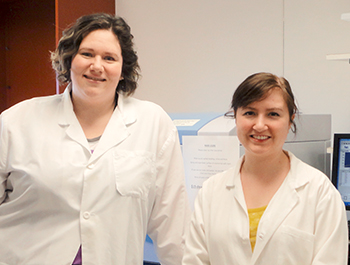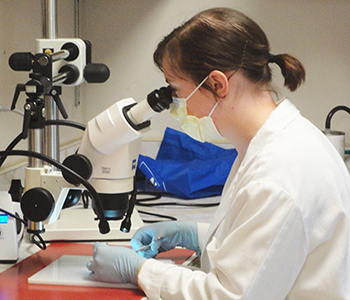Metabolic Phenotyping Core Running at Full Speed
Established by the Fraternal Order of the Eagles Diabetes Research Center, the Metabolic Phenotyping Core offers an expanding repertoire of services for measuring metabolic output in cells and animals.

Jamie Soto and Erin Lane in the Metabolic Phenotyping Core.
The core has grown considerably since its establishment in 2013 by Dr. Dale Abel. Run by Jamie Soto and Erin Lane, the core provides a number of services that are useful for researchers in need of methods to track energy expenditure. “One of our most used instruments” says Jamie “is the NMR”, a Bruker Minispec LF-90II that quickly measures body composition (fluid, fat, and lean tissue) for both experimental mice and rats. Another service offered is the ability to tightly measure caloric intake and expenditure using the Comprehensive Lab Animal Monitoring System (CLAMS), which non-invasively tracks movement, sleep, food consumption, CO2 production, and O2 consumption and can be coupled with telemetry devices to measure other parameters such as body temperature.
For cell culture work, the facility also has a Seahorse XF-24 that can continuously monitor glycolytic and mitochondrial metabolism by tracking lactic acid and O2 consumption. The Seahorse is typically used in cultured cells, but recently the facility has used it to measure metabolism in tissues. This Seahorse runs 24 samples at one time. Although this is less than the 96 samples that can be measured by the Seahorse Bioscience XF96 available in the Radiation and Free Radical Research Core, the dynamic range is higher allowing cells with very high metabolic output to be accurately measured. In addition, availability of the Seahorse XF-24 in the metabolic phenotyping core is excellent.

Erin Lane working in the Metabolic Phenotyping Core.
A major addition to the metabolic phenotyping core came when Erin Lane studied with David Wasserman who directs the Mouse Metabolic Phenotyping Center at Vanderbilt University. Now the core can measure insulin action as well as glucose utilization and distribution within whole animals in several experimental settings. “One particular challenge” says Erin “ was perfecting the hyperinsulinemic-euglycemic clamp technique. But with the training from Vanderbilt and help here from Dr. Andy Norris these methods are now well-established routine and working well.”
The metabolic phenotyping core now occupies lab space in 329 MRC, with the anticipation of moving to Med Labs after an extensive renovation for a state of the art facility. On the horizon is the expansion of other mouse phenotyping services relevant to energy utilization, cardiac function, and other processes relevant to Diabetes Research here at Iowa.